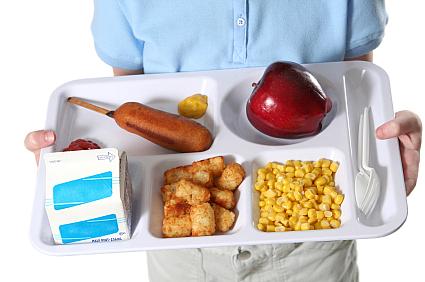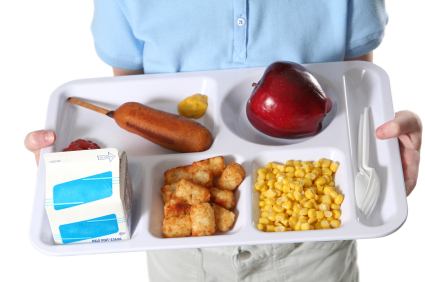School Food Politics: What's Missing From the Pizza-as-Vegetable Reporting

 In this guest post, "Appetite for Profit" author Michele Simon unpacks what journalists got right - and wrong - about this week's school lunch nutritition controversy, and how to add more context to your reporting on the issue. You can read more about Simon's work at her website and in Antidote blogger William Heisel's earlier interview with her.
In this guest post, "Appetite for Profit" author Michele Simon unpacks what journalists got right - and wrong - about this week's school lunch nutritition controversy, and how to add more context to your reporting on the issue. You can read more about Simon's work at her website and in Antidote blogger William Heisel's earlier interview with her.
Over the last couple of days, news outlets have been having a field day with a proposal from Congress that pizza sauce be considered a vegetable to qualify for the National School Lunch program. Headlines like this one were typical: "Is Pizza Sauce a Vegetable? Congress says Yes." (The blogs were a tad more childish; for example LA Weekly: Congress to USDA: Pizza is So a Vegetable, Nah Nah Nah Nah Nah Nah.)
Most reporters, pressed for time and resources, tend to simplify complex stories and this was no exception. In one camp, so the stories went, are nutrition advocates who want healthier school meals, while Republicans are saying the feds shouldn't be making such decisions. Here is one example of this framing of the story:
Conservatives in Congress say the federal government shouldn't be telling children what to eat. They say requirements proposed by the President went too far, costing budget strapped schools too much. Local schools are caught in the middle.
Meanwhile, a few other reports did a better job of explaining the massive industry lobbying at play. (See, for example, Mother Jones' Tom Philpott and Ed Bruske aka The Slow Cook, a hero in school food reporting.)
And while it was easy to compare this current craziness to the Reagan-era infamous "ketchup-is-a-vegetable" school lunch proposal (which did not pass), a bit more history, common sense, and political context is needed.
History: As much as the GOP would like to hang this on Obama, the effort to improve the quality of school meals dates back decades. In the mid 1990′s a huge battle was finally won to bring school nutrition in line with federal government's own dietary advice. Since that time, science evolved and the standards needed updating. We also had the increasing problem of school vending loaded with soft drinks and candy. Then in 2004, (yes, during Bush) Congress authorized USDA to improve nutrition standards for school food. Finally at the request of USDA, the Institute of Medicine released a report in 2009 with very specific recommendations for USDA to follow – based on science. So this process has been going on long before the current budget crisis and before Obama could get blamed for everything since the dawn of time.
Common sense: If you stop and think about it, shouldn't all food assistance programs (i.e., paid for with taxpayer dollars), at the very least, comply with the Dietary Guidelines for Americans, which is supposed to be based on the latest nutrition science? Recall the feds' new MyPlate, released to much fanfare earlier this year, which recommends half the meal be comprised of fresh fruits and vegetables, not tater tots and pizza.
Politics: As I said, a few reports did mention the lobbying by, for example, the American Frozen Food Institute. (Yes, there's a trade group for frozen pizza, fries, and other school food abominations; and surprise, they are thrilled with this outcome.) But almost everyone missed the industry front group,"The Coalition for Sustainable Meal Programs." (I could not make that one up.) And once again, we need more context.
This issue isn't just that the processed food industry is upset with proposed improvements to school meals, it's how they are flexing their political muscle to get their way. The critical (and most under-reported) part of this story is how Congress has hijacked the USDA regulatory process to do the food industry's bidding.
Congress is putting language to undercut the USDA rules into its agriculture appropriations bill, a sneaky move used when you want something to pass outside of the usual legislative (and in this case regulatory) process.
You know things are bad politically when even the USDA (seeming a tad shell-shocked) defended its proposed rules, telling the Washington Post that keeping pizza in schools won't save any money, as the GOP claimed.
Let's recap: Congress authorized USDA to improve the nutritional quality of school meals seven years ago. USDA commissioned a report from the IOM to help the agency do exactly that, based on the best available science. USDA subsequently proposed regulations, has taken public comment, and should then come out with final regulations. Civics 101 folks: Congress makes the laws and the exectutive branch carries them out. Agencies such as USDA are the experts, not Congress. That is why the legislature delegates authority to the agency in charge. But here, the food industry didn't get what it wanted through the normal channels, so it went to Congress, which usurped the entire process. I'd love to see reporters asking: how the hell did that happen?
And let's not forget this is supposed to be about our nation's kids. Which raises one more interesting question: Where exactly is Michelle Obama and her Let's Move campaign now? The First Lady has been a champion for improving school meals but of course she has no real power. The food industry has plenty.
And while politicians curry favor with lobbyists, schoolchildren will pay the ultimate price, with their health.

